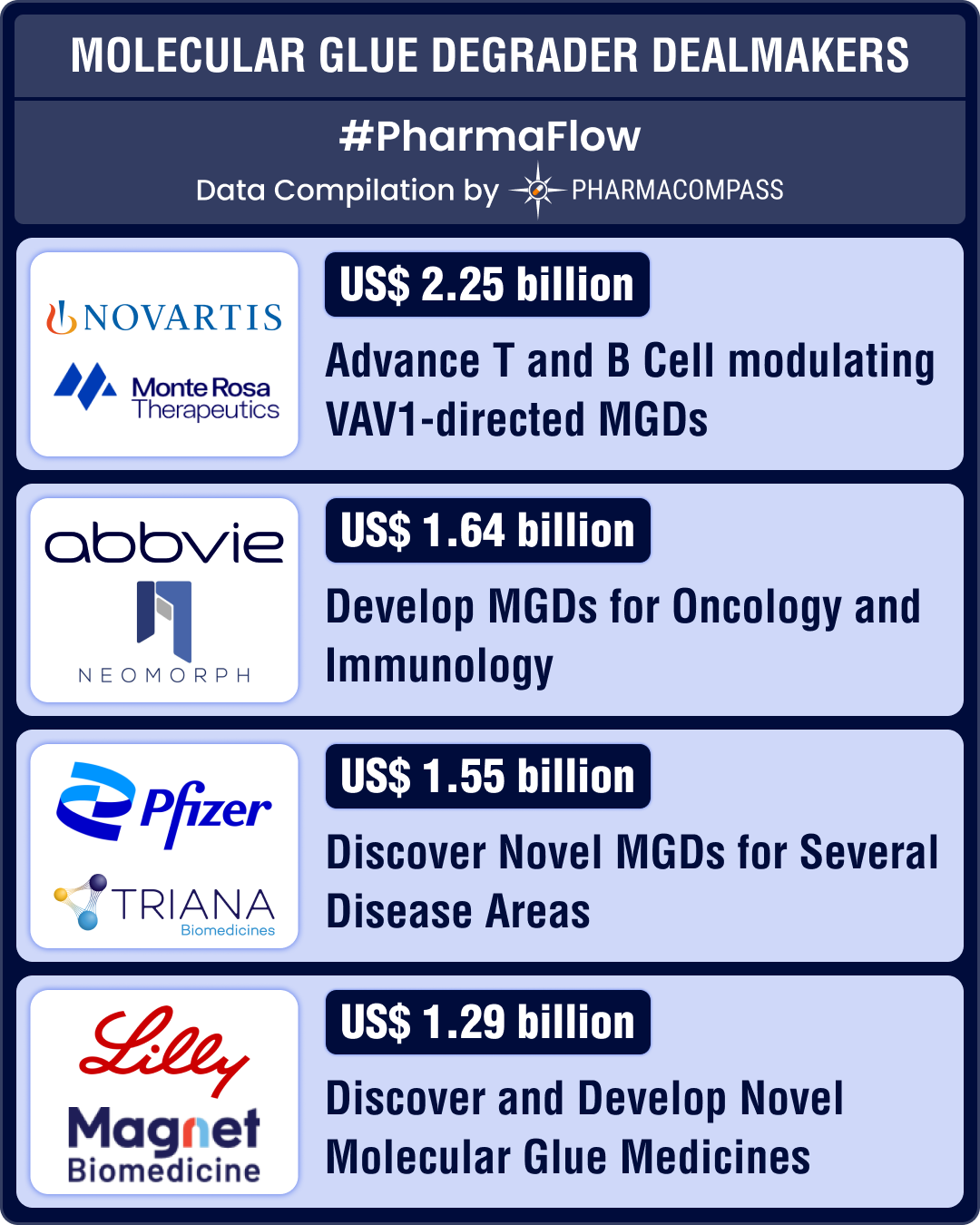
By PharmaCompass
2025-03-27
Impressions: 3993
This week, we delve into molecular glue degraders (MGDs), one of the most promising frontiers in drug development. MGDs address a vast number of previously “undruggable” disease-causing proteins.
Unlike traditional small molecule drugs that require specific binding pockets, MGDs function by enhancing protein-protein interactions. MGDs selectively target disease-causing proteins and an enzyme known as E3 ubiquitin ligase. By creating a binding interface between the two, MGDs destroy the target proteins.
Another kind of degraders are proteolysis targeting chimeras (PROTACs) that use a bifunctional approach — one binds the target proteins, and the other binds to an E3 ligases together. These degraders induce the degradation of specific proteins by using the cell’s natural ubiquitin-proteasome system (a process in cells where damaged or unneeded proteins are tagged by a small molecule called ubiquitin and then broken down by a structure called the proteasome so that cells stay healthy and function properly).
MGDs constitute a rapidly growing market, where both the targeted protein degradation technologies and investment in research and development are witnessing growth.
Currently, the most recognized molecular glues are the immunomodulatory imide drugs (IMiDs), such as thalidomide, lenalidomide and pomalidomide, which have been around for some time. According to GlobalData, lenalidomide generated over US$ 6 billion in sales in 2023, thereby demonstrating the commercial viability of this therapeutic approach.
Lilly, AbbVie ink billion-dollar MGD deals; Biogen partners Neomorph; Pfizer, Triana ink collaboration
The MGD space has witnessed extraordinary deal-making activity over the recent months, with major pharmaceutical companies committing billions of dollars to secure access to novel MGD platforms and pipelines. This surge in investment reflects the industry’s growing confidence in the therapeutic potential of MGDs to address previously undruggable targets.
This year has already seen two landmark deals. In February, Magnet Biomedicine entered into a collaboration and license agreement with Eli Lilly worth up to US$ 1.29 billion to discover and develop novel MGDs. This partnership leverages Magnet’s TrueGlue discovery platform and approach with Lilly’s expertise in the development of small molecule therapeutics.
In January, AbbVie crafted a US$ 1.64 billion deal with molecular glue biotech Neomorph, combining AbbVie’s oncology and immunology drug development capabilities with Neomorph's leading molecular glue discovery platform.
While oncology remains the primary focus, these collaborations are increasingly expanding into neurodegenerative diseases, immunological disorders, and other therapeutic areas. For instance, in October, Biogen and Neomorph announced a multi-target research collaboration to discover and develop MGDs for Alzheimer’s, rare neurological, and immunological diseases, potentially worth up to US$ 1.45 billion.
October also saw Novartis sign a potential US$ 2.25 billion deal with Monte Rosa Therapeutics. The deal gives Novartis exclusive worldwide rights to develop, manufacture and commercialize multiple MGDs (including MRT-6160) for undruggable targets, including in the areas of immunology and inflammation, metabolism, and genetic diseases.
Earlier in October, Triana Biomedicines and Pfizer entered into a research collaboration to discover novel MGDs for multiple targets across several disease areas, including oncology, with a total potential value of up to US$ 1.55 billion.
And in August 2024, SEED Therapeutics entered into a strategic research collaboration with Eisai to discover and develop novel MGDs for neurodegenerative and oncological indications, potentially worth up to US$ 1.5 billion.
BMS leads with three MGDs in late-stage trials; Monte Rosa’s MRT-2359 targets solid tumors
Bristol Myers Squibb has established itself as a leader in the clinical development of MGDs with three products in late-stage development. These include a next-gen MGD mezigdomide (CC-92480), which is currently in phase 3 trials in combination with carfilzomib and dexamethasone for relapsed/refractory multiple myeloma. Another candidate is golcadomide, which is in late-stage clinical trials for high-risk first-line large B-cell lymphoma. And the third MGD in BMS’ portfolio is iberdomide, which has reached phase 3 development for multiple myeloma.
Monte Rosa Therapeutics has made significant progress with MRT-2359, an investigational MGD that is currently in phase 1/2 clinical trials for the treatment of patients with MYC-driven solid tumors, including non-small cell lung cancer, small cell lung cancer, and high-grade neuroendocrine cancer. Myelocytomatosis or MYC is a gene which causes various solid tumors when overactive.
MRT-2359 represents an important advancement in extending the molecular glue approach beyond hematological malignancies to solid tumors, which have historically proven more challenging to address with protein degradation strategies.
Other significant early-stage candidates are Nested Therapeutics’ NST-628 and Plexium's PLX-4545. NST-628 relies on a novel mechanism of action in its category of RAS-MAPK inhibitors, and overcomes some traditional limitations in the treatment of cancers.
PLX-4545 is Plexium’s first small molecule degrader program to enter clinical development. This potent and selective MGD of a classically undruggable transcription factor, also known as Helios (IKZF2), explores treating solid tumors. Transcription factors are proteins that regulate gene expression by binding to specific DNA sequences.
Boehringer’s KRAS degrader advances PROTACs approach; Arvinas tests ARV-102 for neurodegenerative diseases
Like MGDs, PROTACs are also witnessing advancements in both R&D and dealmaking. For instance, BridGene Biosciences recently expanded its strategic collaboration with Galapagos to develop a selective oral SMARCA2 PROTAC in precision oncology. The SMARCA2 gene provides instructions for making one piece (subunit) of a group of similar protein complexes known as SWI/SNF complexes.
In the clinical arena, Prelude Therapeutics announced a collaboration with Merck to evaluate PRT3789 in combination with Keytruda (pembrolizumab) in patients with SMARCA4-mutated cancers. PRT3789 is a potent and highly selective, first-in-class SMARCA2 degrader.
On the molecular front, ACBI3, a novel pan-KRAS degrader developed through a collaboration between the University of Dundee and Boehringer Ingelheim, addresses a critical gap in cancer therapy by targeting 13 out of 17 prevalent KRAS mutants.
KRAS mutation is a change in the KRAS gene, a common gene that can cause cancer. ACBI3’s development is a potential breakthrough for millions of cancer patients with KRAS-driven tumors.
Vepdegestrant (ARV-471), a collaborative effort between Arvinas and Pfizer, remains the most advanced PROTAC candidate to date and has met its primary endpoint in a late-stage study in breast cancer patients with estrogen receptor 1 mutations. Similarly, Arvinas’ ARV-102 became the first PROTAC to be tested in humans for neurodegenerative diseases, marking a significant milestone in addressing brain-related disorders.
Our view
MGDs offer a new, and groundbreaking approach to treating cancers and various other diseases, thereby attracting substantial investments by major pharmaceutical companies. As clinical trials show encouraging results, we expect investments in the MGDs space to increase even further.
The PharmaCompass Newsletter – Sign Up, Stay Ahead
Feedback, help us to improve. Click here
Image Credit : MOLECULAR GLUE DEGRADER DEALMAKERS by PharmaCompass license under CC BY 2.0
“ The article is based on the information available in public and which the author believes to be true. The author is not disseminating any information, which the author believes or knows, is confidential or in conflict with the privacy of any person. The views expressed or information supplied through this article is mere opinion and observation of the author. The author does not intend to defame, insult or, cause loss or damage to anyone, in any manner, through this article.”








